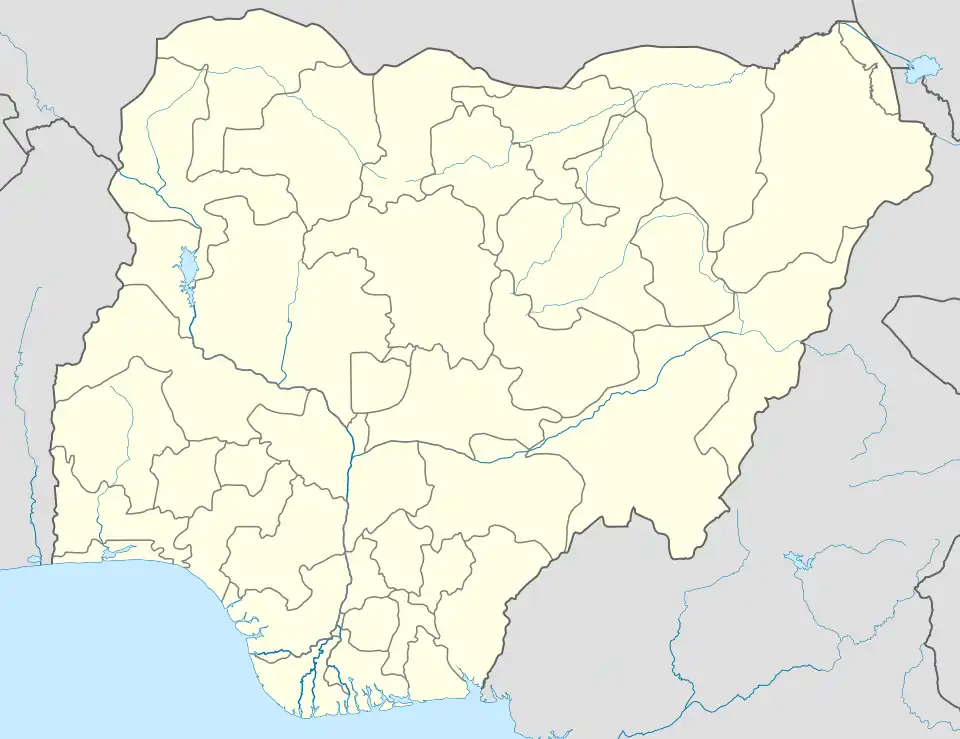Sam Mbakwe Airport
Sam Mbakwe International Cargo Airport (IATA: QOW, ICAO: DNIM), also known as Imo State Airport, serves Owerri, the capital city of Imo State in southeastern Nigeria. It is located in Ngor Okpala Local Government Area, Imo State.
Sam Mbakwe International Cargo Airport (SMICA) Imo Airport | |||||||||||
|---|---|---|---|---|---|---|---|---|---|---|---|
| Summary | |||||||||||
| Airport type | Public | ||||||||||
| Owner/Operator | Federal Airports Authority of Nigeria (FAAN) | ||||||||||
| Serves | Owerri, Nigeria, Aba, Nigeria, Umuahia, Nigeria | ||||||||||
| Elevation AMSL | 374 ft / 114 m | ||||||||||
| Coordinates | 5°25′35″N 7°12′20″E | ||||||||||
| Map | |||||||||||
 QOW Location of the airport in Nigeria | |||||||||||
| Runways | |||||||||||
| |||||||||||
| Statistics (2015) | |||||||||||
| |||||||||||
The building of the airport commenced with the administration of the first civilian governor of the old Imo State (now, Imo, Abia and Southern Ebonyi states), Dee Sam Mbakwe, in 1983, from generous contributions of the indigenes and people of the state and throughout the Igbo land. It is to be noted that while this is the first state owned airport, it is worthy to acknowledge also that it is the first community driven airport project ever known, at least, in the West of Africa. The project also enjoyed immense support from successive Federal Military Governments especially under Navy Captain James N.J. Aneke, who saw to its completion, commissioning and operational commencement on 15th July 1994, under the late General Sani Abacha.
Other cities served by the airport are, the commercial city of Onitsha, automobile and manufacturing city of Nnewi in Anambra State, the industrial hub of Aba, Umuahia and Arochukwu in Abia State. Others are Okigwe, Oguta, and Orlu business districts in Imo State. The airport also serves some parts of Akwa Ibom and Cross River States in the South South (southernmost part) of Nigeria.
The airport is named after Sam Mbakwe, the first civilian governor of Imo State who started the project. As mentioned, it is the first state-government-built airport built from the support and contributions of indigenes of the state and entire Igbo land.[4] Navy Captain James N.J. Aneke, who was the military administrator of Imo State from 9th December 1993 to 22nd August 1996, completed and commissioned the airport on 15th July 1994. It was later handed over to FAAN (Federal Airport Authority of Nigeria) to be managed by the federal government.
Facilities
The airport underwent upgrading in 2013-14 that covered its infrastructure and the communication equipment covering the airspace past Port Harcourt Airport as part of the Total Radar Coverage of Nigeria (TRACON) project.[5]
The airport has night landing capabilities, but for most flights in non-international designated airports, the Federal Airports Authority of Nigeria restricts night operations except for passenger flights during pilgrimage (Hajj).
Airlines and destinations
| Airlines | Destinations |
|---|---|
| Air Peace | Abuja, Lagos |
| Arik Air | Lagos |
| Azman Air | Abuja |
| United Nigeria Airlines | Abuja |
Statistics
These data show number of passengers movements into the airport, according to the Federal Airports Authority of Nigeria's Aviation Sector Summary Reports.
| Year | 2005 | 2006 | 2007 | 2008 | 2009 | 2010 | 2011 | 2012 | 2013 | 2014 | 2015 |
|---|---|---|---|---|---|---|---|---|---|---|---|
| Passengers | 66,093 | 345,078 | 457,544 | 200,097 | 276,926 | 476,063 | 384,016 | 265,082 | 267,532 | 338,943 | 313,343 |
| Growth (%) | |||||||||||
| Source: Federal Airports Authority of Nigeria (FAAN). Aviation Sector Reports (2010-2013,[6] 2014,[7] Q3-Q4 of 2015,[8] and Q1-Q2 of 2016,[9]) | |||||||||||
References
- Airport information for DNIM from DAFIF (effective October 2006)
- Airport information for QOW at Great Circle Mapper.
- Google Maps - Owerri
- "Dailytrust News, Sports and Business, Politics | Dailytrust". Daily Trust. Retrieved 2022-05-16.
- Nigerian Airspace Management Agency - TRACON
- Passenger Only Aviation Data Report 2010-13 to Q1 2014
- Aviation Sector Summary Report Q4 2014 - Q1 2015
- NIGERIA AVIATION SECTOR Q3-Q4 2015 REPORT
- Nigerian Aviation Sector Summary Report: Q1-Q2 2016